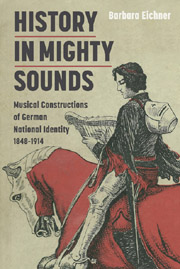Book contents
- Frontmatter
- Contents
- List of Illustrations
- List of Music Examples
- Acknowledgements
- Abbreviations
- Dedication
- Introduction
- 1 The Pure Mirror: National Epic as National Opera
- 2 Germanic Heroes for Modern Germans: Gender and the Nation
- 3 Lost in Transfiguration: Redemption Operas in the Fin de siècle
- 4 The Sacred Nation and the Singing Nation: The Choral Movements
- 5 Symphonic Visions from the Periphery
- Bibliography
- Index
4 - The Sacred Nation and the Singing Nation: The Choral Movements
Published online by Cambridge University Press: 05 February 2013
- Frontmatter
- Contents
- List of Illustrations
- List of Music Examples
- Acknowledgements
- Abbreviations
- Dedication
- Introduction
- 1 The Pure Mirror: National Epic as National Opera
- 2 Germanic Heroes for Modern Germans: Gender and the Nation
- 3 Lost in Transfiguration: Redemption Operas in the Fin de siècle
- 4 The Sacred Nation and the Singing Nation: The Choral Movements
- 5 Symphonic Visions from the Periphery
- Bibliography
- Index
Summary
Despite the high density of theatres across the German-speaking countries, where the music-loving public could experience new operas even in many provincial towns, most people encountered large-scale works in the form of choral music, either as active singers in one of the many mixed or male choirs or as part of the sizeable audiences attracted by concerts and music festivals. For the Vormärz years James Garratt rightly considers the choral movement and its manifestations the ‘principal forum for mass amateur musical participation’, a forum that emphasised not the outstanding creative effort of the individual – though the choral movement had its fair share of genius worship – but rather the experience of a collective united in and through art. In the context of nineteenth-century Germany, such unity was first and foremost imagined to reside in a national community, and time and again the ‘harmony’ of the assembled singing multitude was interpreted as anticipating the harmonious nation that unification would engender. Mixed and male-voice choirs often recruited from the same social strata and shared many ideals, such as the free association of like-minded people or the leading role of the educated middle classes in the sphere of culture. Although both types of choral association congregated at increasingly massive festivals in order to ‘display in monumental form the cohesion and collective strength of the middle classes’, they set their priorities slightly differently. Mixed choirs found their most prestigious outlet in the genre of the oratorio, mainly performed at concerts and music festivals that emphasised the collective aesthetic experience in moral and religious terms that made them adequate – if not obvious – vehicles for the national cause.
- Type
- Chapter
- Information
- History in Mighty SoundsMusical Constructions of German National Identity, 1848-1914, pp. 163 - 228Publisher: Boydell & BrewerPrint publication year: 2012



